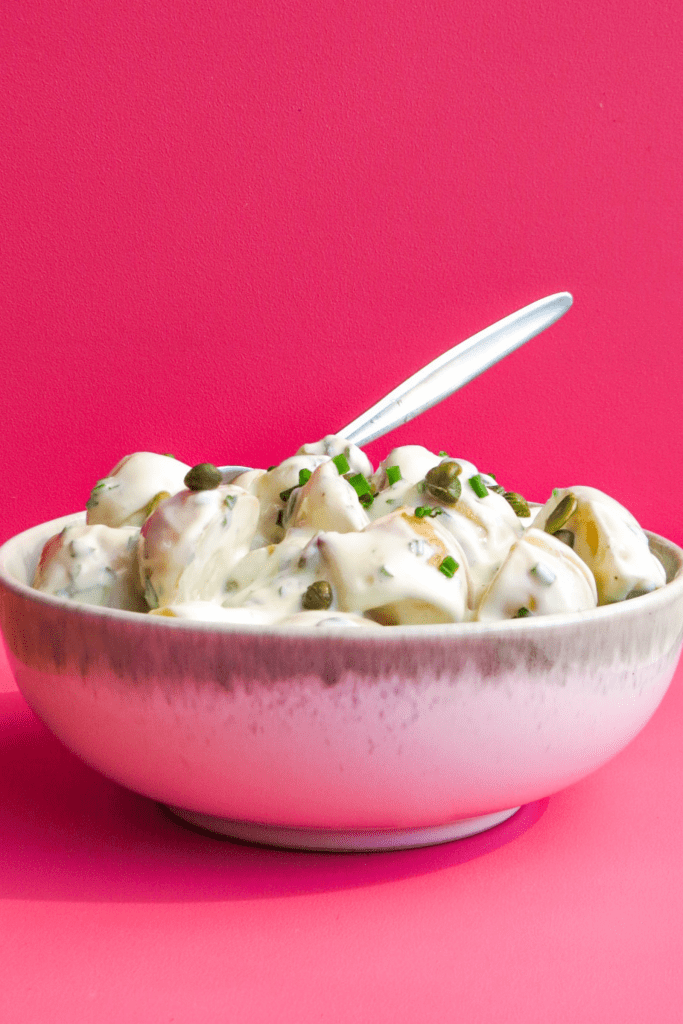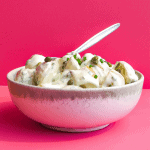Try a lighter potato salad with loads of flavour and a combination of prebiotics and probiotics to support healthy gut flora.
Many popular diets shun potatoes as being high in carbohydrates.
While excessive sugar consumption can wreak havoc on our health, the humble potato (like other complex carbohydrates) is not the villain it’s made out to be.
Potatoes are actually quite nutritious. They are high in fibre, B vitamins, potassium and vitamin C. Plus, if we’re going to name superfoods, which don’t actually exist by the way, the potato should make the list. This is because potatoes are a great source of resistant starches.
Cold potatoes are a source of resistant starch (prebiotics)
Potato and rice contain resistant starches that are increased by cooking and then cooling. Resistant starches pass into the large intestine undigested, which also means cold potato has a lower GI than cooked potato (esp. when combined with lemon juice or vinegar).
In the large intestine, resistant starches are used by the healthy gut bacteria, which produce by-products that provide nourishment for the intestinal cells and can improve colon health. Therefore, cold potato is considered a prebiotic food, and thus is a super-duper food for your health!
To unleash these health-promoting resistant starches, we need to precook potatoes by boiling, steaming or roasting. Boiling is a great method to prepare potatoes for many other preparations such as potato straight up, mashed potato, roasted potatoes, and clearly, potato salad, whether a French-style or the traditional mayo variety, which is what this recipe is based on.
Combining prebiotics and probiotics for gut health
ln this Greek yogurt potato salad recipe, I use yogurt rather than mayo, as it contains probiotics that will work in concert with the prebiotic-resistant starches in the cold potato. It’s somewhat a match made in heaven from a health and taste perspective. Although that’s my opinion. I’ll let you be the judge of taste. Let me know if you try the recipe or have any questions in the comments below.
Preparing potatoes for potato salad
Before we get to the recipe, I’d like to share some considerations for preparing potatoes for potato salad. You may be well aware of this and want to skip ahead to the recipe. If so, go right ahead.
However, if you’re a little unsure, read on. And there is no shame here. I ate mostly raw food for years during my dieting days. So, even I had to swat up on cooking potatoes when I started forming a more intuitive relationship with food.
Choosing potatoes for potato salad
The best potatoes for potato salad are waxy potato varieties as they will hold their shape better when cooked than floury varieties, which are best for smashing or mashing. There are different varieties available in different countries and at different times of year. Often, the box potatoes come in, or the sign the supplier puts on the potatoes will tell you what they are suitable for. This is always worth considering as some potato varieties may start their harvest season as waxy and end the season floury.
Here in New Zealand, potato varieties that are delicious in potato salad are Perlas, Nadine and Piccolos Gold. I like the baby potatoes available in a box as they can easily be cooked whole. Cooking potatoes with the skin on them may provide additional nutrients and reduce the leaching of nutrients into the water, which brings me to the next consideration.
Preparing potatoes for boiling
Boiling potatoes ensures that they are evenly cooked through for a delicious salad.
To prepare the potatoes for boiling, rinse them to remove dirt and cut out blemishes.
Leave the skin on as it provides beneficial fibre and antioxidants, especially potatoes with coloured skins, such as yellow or red. The skin can also add flavour and texture.
Then, cook the potatoes whole or cut them into smaller pieces.
How to boil potatoes
The main secret here is to put potatoes in cold water, not boiling water, as boiling water will cause the outside to cook faster than the inside, resulting in an uneven texture.
Simply place the potatoes in a saucepan. Cover with cold water. Add a pinch of salt and set on the stovetop to boil.
Why add a pinch of salt? Salt will enable the water to boil to a higher temperature, which results in a creamier texture as the potato’s starch is cooked more thoroughly. Furthermore, the salt can flavour the potatoes a smidgin.
Potatoes cut into cubes will take around 15 minutes to cook, while whole potatoes will take 20-25 minutes. To check if they are done, pierce with a fork. The fork should easily push into the potato but shouldn’t break apart or be crumbly.
Once cooked, drain the potatoes immediately to prevent them becoming too soggy. Set aside to cool ready for potato salad assemble. Or enjoy your freshly boiled potatoes in any number of ways—up to you!
Greek Yogurt Potato Salad
Ingredients
- 700 g gourmet baby potatoes left whole and washed with skin on
- 1 cup natural Greek yogurt low or full fat
- 2 tablespoons finely chopped chives
- 2 tablespoons finely chopped parsley
- ¼ cup pepitas (pumpkin seeds) raw or toasted (optional)
- 1 tablespoon capers optional
- 3 teaspoon lemon juice
- 1 teaspoon garlic or onion powder
- 1 teaspoon mustard powder or Dijon mustard
- pinch freshly ground black pepper to taste
- pinch salt to taste
Instructions
- Place potato in cold water with a pinch of salt and boil for 20-25 minutes until tender, can easily be pierced with a fork but do not break apart. Drain.
- Set aside until the potatoes are cold—this could be done the day before making the salad.
- Cut the potatoes in halves or quarters, to any size you choose.
- Whisk together all the ingredients, except for the potatoes.
- Then combine the dressing with the potatoes in a large mixing bowl until the potatoes are evenly covered. Taste and adjust the seasoning, adding more salt and pepper if desired.
- Cover and chill for several hours.
- Garnish with additional fresh herbs before serving, if you’d like.
Recipe upgrades
Although this recipe, in my opinion, is delicious, you may like to try adding some different flavours and textures. Here are just a few of my ideas.
- Try adding diced semi-dried tomatoes, olives, pickles, crumbled feta, sauerkraut, slithers of roasted garlic, boiled egg or chopped chorizo sausage.
- Spice it up with paprika or turmeric.
- Try other herbs such as dill, basil or mint.
- Add other vegetables such as grated carrot, finely diced cucumber, thinly sliced red onion, finely chopped celery, corn kernels or peas
Get creative and reignite a love of potatoes!
Love potato? Love this recipe?
Let me know in the comments below.
I’d love to hear from you. Maybe you made a modification to the recipe that others could benefit from. Or perhaps you have a request for another recipe or would love to hear my perspective on another nutrition topic. Please get in touch.


